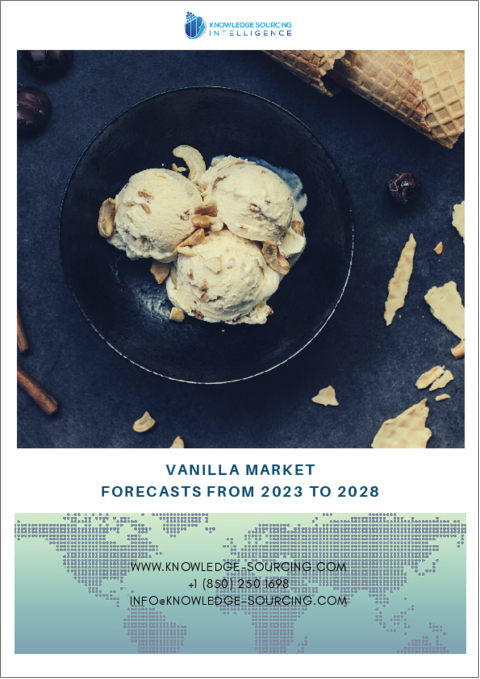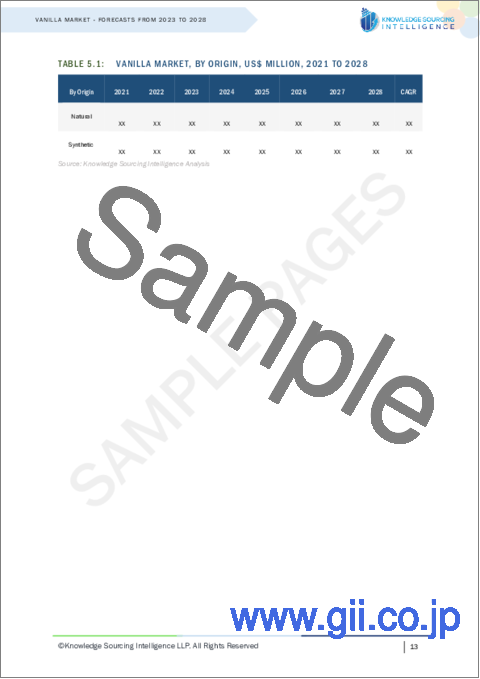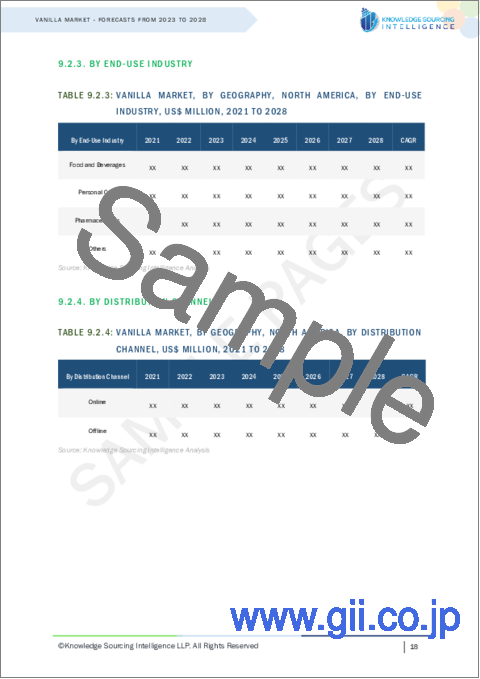|
|
市場調査レポート
商品コード
1410245
バニラの世界市場:予測(2023~2028年)Vanilla Market - Forecasts from 2023 to 2028 |
||||||
カスタマイズ可能
|
|||||||
| バニラの世界市場:予測(2023~2028年) |
|
出版日: 2023年12月05日
発行: Knowledge Sourcing Intelligence
ページ情報: 英文 152 Pages
納期: 即日から翌営業日
|
- 全表示
- 概要
- 目次
世界のバニラの市場規模は、2021年に10億6,195万5,000米ドルに達し、CAGR 6.88%で成長し、2028年には16億9,173万1,000米ドルに達すると予測されています。
消費者の天然香料に対する需要の高まりと食品・飲料分野の拡大がバニラ市場の主な促進要因です。バニラの商業的魅力は、菓子類やペストリーでの使用、健康・ウェルネス運動の高まりに影響されています。市場力学は、バニラ栽培の新地域への広がりとサプライチェーンの難しさによって影響を受けています。市場は、高級な手作り品への欲求によってさらに前進しています。バニラ市場は、持続可能な慣行と抽出技術に関する継続的な研究と革新により、競争力を高めています。
CBIによると、欧州はバニラの主要市場のひとつです。フランス、ドイツ、オランダを合わせると、全世界の輸入量の約32%(欧州では全輸入量の75%)を占め、米国全体では42%です。低開発国から欧州へのバニラの輸入量は、2017年の1,186トンから2021年には1,470トンに増加しました。さらに、欧州は2021年に3億5,600万ユーロ相当のバニラを購入しました。
栽培を促進する政府の取り組み。
貿易協定、品質基準、農業補助金など、農業を支援し、国際商取引を促進し、製品の品質を保証する政府のプログラムは、バニラ市場に影響を与えます。例えば、2023年9月、米国国際開発庁(USAID)を通じて、米国政府はSAVA地域のバニラ生産者を支援し、環境を保全しながら収益を高め、販路を拡大しました。2020年以降、このプロジェクトはプレミアムバニラの売上を280%増加させ、500万トン以上の炭素を隔離しました。さらに2023年10月には、フロリダ大学熱帯研究教育センターの研究者が、バニラの徹底的な分析を開始しました。この分析には、肥料ガイドラインの作成、高収量で病気に強い品種の創出、バニラ含有量が最も多い豆の割り出しなどが含まれます。
様々なエンドユーザーからの需要の高まり
需要の増大は、様々なエンドユーザー分野のバニラ産業に大きな影響を与えています。主香料としてのバニラの需要は、食品・飲料分野、特にパンや菓子類の需要の増加から直接影響を受けています。バニラの人気が高まるにつれ、健康志向から天然素材が好まれるようになり、市場アピールが高まります。さらに、プレミアムバニラの重要性は、職人的でプレミアムな商品への欲求によって高まっています。バニラ市場力学とその全体的な成長は、エンドユーザー産業の開拓と顧客の嗜好の変化によって大きく形成されます。
欧州連合(EU)の業界団体でFood Drink Europeによると、EUの食品・飲料産業はEU最大の産業セクターのひとつであり、Data & Trends 2022によると、460万人を雇用し、1兆1,000億ユーロの売上高と2,300億ユーロの付加価値を生み出しています。食品・飲料セクターは、EU加盟27カ国のうち半数で製造業に従事する最も多くの人々を雇用しています。
さらに、腸球菌(Enterococcus faecium)、黄色ブドウ球菌(Staphylococcus aureus)、肺炎桿菌(Klebsiella pneumoniae)などのMDR菌による感染症が流行していることから、抗生物質としての特性を持つファイトケミカル(植物化学物質)のような、新規の代替または補助的な治療法を研究することが重要です。香料としての使用に加え、バニラの生理活性成分であるバニリンとバニリン酸は、抗菌性を含む健康上の利点が長い間認められてきました。
アメリカのバニラ市場は安定した成長が見込まれています。
同国では、乳製品の需要が増加し、コーヒーの消費量が増加していることに加え、アイスクリームの消費量も増加していることから、バニラの市場は今後数年間で拡大すると予想されます。米国では、バニラ生産強化のための助成金が増加していることも、バニラの高成長に寄与しています。例えば、米国農務省(USDA)は、フロリダ大学の助教授にUF/IFASのバニラ調査を強化するための補助金を交付し、国内産業の振興を図っています。バニラの用途は、ケーキからキャンドル、咳止めから洗浄液まで多岐にわたる。
さらに、米国農務省は、2023年10月、バニラがフロリダ州南部の小規模農家にとって次の大きな作物となる可能性があるとしています。同州は、南部地域の小規模農家に、野菜や果物の生産に代わる高価値の作物を与える可能性のある新しい作物の先端を走っています。さらに、トピカル研究開発センターの研究者たちは、推奨肥料の開発から最高収量、耐病性品種の開発、バニラ含有量の最も高い豆の特定まで、バニラの包括的評価に着手しています。従って、バニラの研究開発の増加と生産量の増加は、米国における予測期間中に市場を促進すると予想されます。
市場開拓の主な発展
- 2023年10月、Rodelle社はカナダのWalmart社との新たな提携の一環として、ケベックからバンクーバーまでの227の小売店で、人気の高いFairtrade Organic Pure Madagascar Bourbon Vanilla Extract(59ミリリットル/2オンスサイズ)とVanilla Bean Paste(59ミリリットル/2オンスサイズ)を販売開始しました。
- 2022年6月、バニラの生産者を支援するため、チョコレート生産者であるBarry Callebautとバニラのサプライヤーであるプロバが加わった。社会的、健康的、教育的イニシアチブを通じ、アライアンスは地域社会への資金援助や支援も行っています。持続可能な貿易イニシアティブ(IDH)は、持続可能な原材料のみを使用するという両企業の義務を支持し、この最新の誓約を支持しています。
目次
第1章 イントロダクション
- 市場概要
- 市場の定義
- 調査範囲
- 市場セグメンテーション
- 通貨
- 前提条件
- 基準年と予測年のタイムライン
第2章 調査手法
- 調査データ
- 前提条件
第3章 エグゼクティブサマリー
- 調査ハイライト
第4章 市場力学
- 市場促進要因
- 市場抑制要因
- ポーターのファイブフォース分析
- 業界バリューチェーン分析
第5章 バニラ市場:由来別
- イントロダクション
- 天然
- 合成
第6章 バニラ市場:形態別
- イントロダクション
- 豆
- 抽出
- ペースト
- その他
第7章 バニラ市場:最終用途産業別
- イントロダクション
- 食品・飲料
- パーソナルケア
- 医薬品
- その他
第8章 バニラ市場:流通チャネル別
- イントロダクション
- オンライン
- オフライン
第9章 バニラ市場:地域別
- イントロダクション
- 北米
- 南米
- 欧州
- 中東・アフリカ
- アジア太平洋
第10章 競合環境と分析
- 主要企業と戦略分析
- 市場シェア分析
- 合併、買収、合意およびコラボレーション
第11章 企業プロファイル
- Hawaiian Vanilla Company
- Nielsen-Massey Vanillas, Inc.
- Eurovanille
- Symrise
- Indovanili
- Pure Vanilla Madagascar
- Vanilla Impex
- The Mad Spice Company
- Laie Vanilla Company
The vanilla market is expected to grow at a CAGR of 6.88% from US$1,061.955 million in 2021 to US$1,691.731 million in 2028.
The rising demand for natural flavours from consumers and the expansion of the food and beverage sector are the main drivers of the vanilla market. Vanilla's commercial appeal is influenced by its use in confectionery and pastry goods as well as growing health and wellness movements. Market dynamics are impacted by the spread of vanilla cultivation into new areas and supply chain difficulties. The market is further propelled forward by the desire for high-end, handmade goods. The vanilla market is more competitive due to ongoing research and innovation in sustainable practices and extraction techniques.
According to CBI, Europe is one of the major markets for vanilla. Together, France, Germany, and the Netherlands make up around 32% of all imports worldwide (and 75% of all import volumes in Europe), as opposed to 42% for the United States as a whole. Imports of vanilla into Europe from underdeveloped nations rose from 1,186 metric tonnes in 2017 to 1,470 metric tonnes in 2021. Additionally, Europe bought €356 million worth of vanilla in 2021.
Government initiatives to promote cultivation.
Government programs that assist agriculture, promote international commerce, and guarantee product quality such as trade agreements, quality standards, and agricultural subsidies impact the vanilla market. For instance, in September 2023, through the U.S. Agency for International Development (USAID), the U.S. government assisted vanilla growers in the SAVA region in boosting their revenue and expanding their market reach while preserving the environment. From 2020, the project increased sales of premium vanilla by 280% and sequestered more than five million tons of carbon. Furthermore, in October 2023, researchers from the University of Florida's Tropical Research and Education Centre started a thorough analysis of vanilla, which includes creating fertilizer guidelines, creating the highest-yielding, disease-resistant cultivars, and figuring out which beans have the most vanilla content.
Rising demand from various end-users
Growing demand has a substantial effect on the vanilla industry across several end-user sectors. The requirement for vanilla as a primary flavouring agent is directly impacted by increased demand from the food and beverage sector, especially in bread and confectionery items. Vanilla's growing popularity increases its market appeal as customers gravitate towards natural ingredients due to health and wellness trends. Furthermore, the importance of premium vanilla is increased by the desire for artisanal and premium goods. The dynamics of the vanilla market and its overall growth are significantly shaped by the development of end-user industries and changing customer tastes.
As per the Food Drink Europe, an industry confederation in the European Union, the EU food and drink industry is one of the biggest industrial sectors in the EU, employing 4.6 million people and generating a turnover of €1.1 trillion and €230 billion in value-added, according to Data & Trends 2022. The food and drink sector employs the most people in manufacturing in half of the 27 EU members.
Moreover, given the rising prevalence of infections caused by MDR bacteria, such as Enterococcus faecium, Staphylococcus aureus, and Klebsiella pneumoniae, among others, it is critical to investigate novel alternative or adjunct treatment options, such as phytochemicals with antibiotic properties. In addition to its use as a flavoring agent, vanilla's physiologically active components, vanillin and vanillin acid, have long been recognized for their positive health benefits, including antibacterial properties.
The USA's vanilla market is anticipated to grow steadily.
The increasing demand for dairy products and increasing consumption of coffee among the people in the country coupled with the increasing consumption of ice cream in the USA, is expected to boost the market for vanilla in coming years. Increasing grants offered in the country for the enhancement of vanilla production can also contribute to the high growth of vanilla in the United States. For instance, the United States Department of Agriculture (USDA) grants to a University of Florida assistant professor to enhance UF/IFAS Vanilla Research, to promote domestic industry. The use of vanilla is diverse from cakes to candles, from cough drops to cleaning solutions the use of vanilla is increasing which is boosting the market for vanilla in the USA in the projected period.
Additionally, the USDA, in October 2023, vanilla could be the next big crop for small farmers in Southern Florida. The state is on the cusp of new crops that could give small farmers in the southern region of the state a high-value alternative to vegetable and fruit production. Additionally, the researchers at the Topical Research and Education Centers have embarked on a comprehensive evaluation of vanilla, from developing fertilizer recommendations to developing the highest yield, and disease-resistant varieties to identify beans with the best vanilla content. Hence, the increasing research and development, and increasing production of the market for vanilla is expected to propel in the projected period in the USA.
Market Key Developments
- In October 2023, Rodelle's well-liked Fairtrade Organic Pure Madagascar Bourbon Vanilla Extract (59 milliliter/two-ounce size) and Vanilla Bean Paste (59 milliliter/two-ounce size) were made available in 227 retail locations from Quebec to Vancouver as part of the company's new relationship with Walmart in Canada.
- In June 2022, chocolate producer Barry Callebaut and vanilla supplier Prova joined to assist vanilla producers. Through social, health, and educational initiatives, the alliance also finances and supports the local community. The Sustainable Trade Initiative (IDH) backs this most recent pledge, which upholds both businesses' obligations to use only sustainable ingredients.
Segmentation:
By Origin
- Natural
- Synthetic
By Form
- Beans
- Extract
- Paste
- Others
By End-Use Industry
- Food and Beverages
- Personal Care
- Pharmaceuticals
- Others
By Distribution Channel
- Online
- Offline
By Geography
North America
- By Origin
- By Form
- By End-Use Industry
- By Distribution Channel
- By Country
- USA
- Canada
- Mexico
South America
- By Origin
- By Form
- By End-Use Industry
- By Distribution Channel
- By Country
- Brazil
- Argentina
- Others
Europe
- By Origin
- By Form
- By End-Use Industry
- By Distribution Channel
- By Country
- France (including Tahiti)
- Germany
- UK
- Spain
- Others
Middle East and Africa
- By Origin
- By Form
- By End-Use Industry
- By Distribution Channel
- By Country
- Uganda
- Morocco
- Others
Asia Pacific
- By Origin
- By Form
- By End-Use Industry
- By Distribution Channel
- By Country
- China
- Japan
- India
- South Korea
- Indonesia
- Papua New Guinea
- Others
TABLE OF CONTENTS
1. INTRODUCTION
- 1.1. Market Overview
- 1.2. Market Definition
- 1.3. Scope of the Study
- 1.4. Market Segmentation
- 1.5. Currency
- 1.6. Assumptions
- 1.7. Base, and Forecast Years Timeline
2. RESEARCH METHODOLOGY
- 2.1. Research Data
- 2.2. Assumptions
3. EXECUTIVE SUMMARY
- 3.1. Research Highlights
4. MARKET DYNAMICS
- 4.1. Market Drivers
- 4.2. Market Restraints
- 4.3. Porter's Five Force Analysis
- 4.3.1. Bargaining Power of Suppliers
- 4.3.2. Bargaining Power of Buyers
- 4.3.3. Threat of New Entrants
- 4.3.4. Threat of Substitutes
- 4.3.5. Competitive Rivalry in the Industry
- 4.4. Industry Value Chain Analysis
5. VANILLA MARKET BY ORIGIN
- 5.1. Introduction
- 5.2. Natural
- 5.3. Synthetic
6. VANILLA MARKET BY FORM
- 6.1. Introduction
- 6.2. Beans
- 6.3. Extract
- 6.4. Paste
- 6.5. Others
7. VANILLA MARKET BY END-USE INDUSTRY
- 7.1. Introduction
- 7.2. Food and Beverages
- 7.3. Personal Care
- 7.4. Pharmaceuticals
- 7.5. Others
8. VANILLA MARKET BY DISTRIBUTION CHANNEL
- 8.1. Introduction
- 8.2. Online
- 8.3. Offline
9. VANILLA MARKET BY GEOGRAPHY
- 9.1. Introduction
- 9.2. North America
- 9.2.1. By Origin
- 9.2.2. By Form
- 9.2.3. By End-Use Industry
- 9.2.4. By Distribution Channel
- 9.2.5. By Country
- 9.2.5.1. USA
- 9.2.5.2. Canada
- 9.2.5.3. Mexico
- 9.3. South America
- 9.3.1. By Origin
- 9.3.2. By Form
- 9.3.3. By End-Use Industry
- 9.3.4. By Distribution Channel
- 9.3.5. By Country
- 9.3.5.1. Brazil
- 9.3.5.2. Argentina
- 9.3.5.3. Others
- 9.4. Europe
- 9.4.1. By Origin
- 9.4.2. By Form
- 9.4.3. By End-Use Industry
- 9.4.4. By Distribution Channel
- 9.4.5. By Country
- 9.4.5.1. France (including Tahiti)
- 9.4.5.2. Germany
- 9.4.5.3. UK
- 9.4.5.4. Spain
- 9.4.5.5. Others
- 9.5. Middle East and Africa
- 9.5.1. By Origin
- 9.5.2. By Form
- 9.5.3. By End-Use Industry
- 9.5.4. By Distribution Channel
- 9.5.5. By Country
- 9.5.5.1. Uganda
- 9.5.5.2. Morocco
- 9.5.5.3. Others
- 9.6. Asia Pacific
- 9.6.1. By Origin
- 9.6.2. By Form
- 9.6.3. By End-Use Industry
- 9.6.4. By Distribution Channel
- 9.6.5. By Country
- 9.6.5.1. China
- 9.6.5.2. Japan
- 9.6.5.3. India
- 9.6.5.4. South Korea
- 9.6.5.5. Indonesia
- 9.6.5.6. Papua New Guinea
- 9.6.5.7. Others
10. COMPETITIVE ENVIRONMENT AND ANALYSIS
- 10.1. Major Players and Strategy Analysis
- 10.2. Market Share Analysis
- 10.3. Mergers, Acquisitions, Agreements, and Collaborations
11. COMPANY PROFILES
- 11.1. Hawaiian Vanilla Company
- 11.2. Nielsen-Massey Vanillas, Inc.
- 11.3. Eurovanille
- 11.4. Symrise
- 11.5. Indovanili
- 11.6. Pure Vanilla Madagascar
- 11.7. Vanilla Impex
- 11.8. The Mad Spice Company
- 11.9. Laie Vanilla Company






